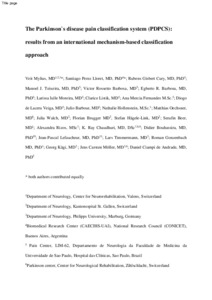Por favor, use este identificador para citar o enlazar este ítem:
https://repositorio.uca.edu.ar/handle/123456789/11621| Título: | The Parkinson`s disease pain classification system (PDPCS): results from an international mechanism-based classification approach | Autor: | Mylius, Veit Pérez Lloret, Santiago Gisbert Cury, Rubens Teixeira, Manoel J. Rossetto Barbosa, Victor Barbosa, Egberto R. Moreira, Larissa Iulle Listik, Clarice Mercia Fernandes, Ana Veiga, Diogo de Lacera Barbour, Julio Hollenstein, Nathalie Oechsner, Matthias Walch, Julia Brugger, Florian Hägele Link, Stefan Beer, Serafin Rizos, Alexandra Ray Chaudhuri, K. Bouhassira, Didier Lefaucheur, Jean-Pascal Timmermann, Lars Gonzenbach, Roman Kägi, Georg Carsten Möller, Jens Ciampi de Andrade, Daniel |
Palabras clave: | DOLOR; ENFERMEDAD DE PARKINSON; CLASIFICACION; ENFERMEDADES NEURODEGENERATIVAS | Fecha de publicación: | 2021 | Editorial: | Elsevier | Cita: | Mylius, V., et al. The Parkinson`s disease pain classification system (PDPCS): results from an international mechanism-based classification approach [en línea]. Postprint del artículo publicado en: PAIN. 2021, 162 (4). doi:10.1097/j.pain.0000000000002107. Disponible en: https://repositorio.uca.edu.ar/handle/123456789/11621 | Resumen: | Abstract: Pain is a common non-motor symptom in patients with Parkinson’s disease (PD) but the correct diagnosis of the respective cause remains difficult because suitable tools are lacking, so far. We developed a framework to differentiate PD- from non-PD-related pain and classify PD-related pain into three groups based on validated mechanistic pain descriptors (nociceptive, neuropathic, or nociplastic), which encompasses the previously described PD pain types. Severity of PD-related pain syndromes was scored by ratings of intensity, frequency, and interference with daily living activities. The PD-Pain Classification System (PD-PCS) was compared with classic pain measures (ie, brief pain inventory (BPI) and McGill pain questionnaire (MPQ), PDQ-8 quality of life score, MDS-UPDRS scores, and non-motor symptoms). 159 non-demented PD patients (disease duration 10.2±7.6 years) and 37 healthy controls were recruited in four centers. PD-related pain was present in 122 patients (77%), with 24 (15%) suffering one or more syndromes at the same time. PD-related nociceptive, neuropathic, or nociplastic pain was diagnosed in 87 (55%), 25 (16%), or 35 (22%), respectively. Pain unrelated to PD was present in 35 (22%) patients. Overall, PD-PCS severity score significantly correlated with pain’s BPI and MPQ ratings, presence of dyskinesia and motor fluctuations, PDQ-8 scores, depression and anxiety measures. Moderate intra- and inter-rater reliability were observed. The PD-PCS is a valid and reliable tool for differentiating PD-related pain from PD-unrelated pain. It detects and scores mechanistic pain subtypes in a pragmatic and treatment-oriented approach, unifying previous classifications of PD-pain. | URI: | https://repositorio.uca.edu.ar/handle/123456789/11621 | ISSN: | 1872-6623 | Disciplina: | MEDICINA | DOI: | 10.1097/j.pain.0000000000002107 | Derechos: | Acceso abierto. 12 meses de embargo | Fuente: | PAIN. 2021, 162 (4) |
| Aparece en las colecciones: | Artículos |
Ficheros en este ítem:
| Fichero | Descripción | Tamaño | Formato | |
|---|---|---|---|---|
| parkinsons-disease-pain-classification.pdf | 974,66 kB | Adobe PDF |  Visualizar/Abrir |
Visualizaciones de página(s)
173
comprobado en 27-abr-2024
Descarga(s)
92
comprobado en 27-abr-2024
Google ScholarTM
Ver en Google Scholar
Altmetric
Altmetric
Este ítem está sujeto a una Licencia Creative Commons

